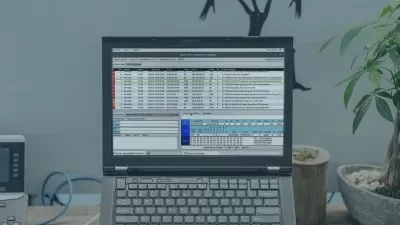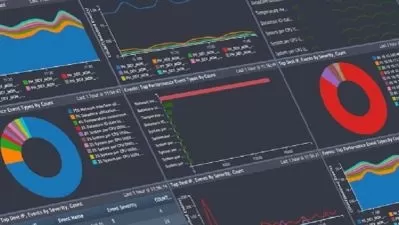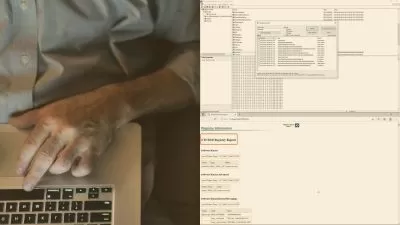Digital Forensics Masterclass : Forensic Science 2023 DFMC+
OCSALY Academy | 160.000+ Students
13:30:31
Description
Learn digital forensics and be computer forensics investigator / Certificate after completing course / DFMC+ / DFIR 2023
What You'll Learn?
- Understanding the role of digital forensics in criminal investigations.
- Investigating online fraud and identity theft.
- Cyber Security for Digital Forensics Investigators
- Malware Analysis
- Investigate Volatile and Non-Volatile Memory
- Investigating the use of encryption and data hiding techniques.
- Data Acquisition
- Evidence Analysis
- Open Source Intelligence
- Fundamentals of Computer Forensics
- Debugging and Analysis Malware
- Mobile Forensics
- Web Browser Forensics
- Linux for Digital Forensics and File Analysis
- Digital Forensics Fundamentals
- Understanding the fundamentals of digital forensics.
- Creating Digital Forensics Lab
- Learning the legal and ethical implications of digital evidence.
- TCP/IP
- Identifying the types of digital evidence that can be collected.
- Networking
- Digital forensics LAW
- Computer Forensics for Beginners
- Knowing the basic concepts of file systems and storage devices.
- Analyzing digital evidence using tools such as EnCase and FTK.
- Identifying evidence of cybercrime, cyberterrorism and other cyber threats.
- Learning about the chain of custody and preserving evidence.
- Investigating network security breaches and incidents.
- Collecting, analyzing and reporting digital evidence.
- Understanding the basic principles of computer forensics.
- Conducting effective digital forensic investigations.
- Understanding cyberstalking and other cybercrimes.
- Detecting and analyzing malware and viruses.
- Analyzing mobile devices for digital evidence.
- Learning about forensic lab equipment and technology.
- Investigating the use of social media and digital communication.
- Examining email and instant messaging for evidence.
- Collecting and analyzing data from cloud storage.
- Analyzing web browsing and internet history.
- Investigating cyberbullying and online harassment.
- Understanding the role of digital forensics in civil litigation.
- Examining the security of computer networks.
- Analyzing forensic evidence in civil and criminal cases.
- Collecting evidence from digital devices such as cameras and DVRs.
- Understanding the basics of cryptography and encryption.
- Conducting forensic investigations in a corporate environment.
- Understanding the impact of technology on the legal system.
- and other awesome topics ->
Who is this for?
What You Need to Know?
More details
DescriptionBecome a Digital Forensics Investigator and learn one of most requested skills of 2023!
This is the most comprehensive, yet straight-forward, course for the Digital Forensics on Udemy!
*Get the Official Certificate after Completing the Course
Welcome to the Digital Forensics Masterclass, the ultimate guide to the world of digital forensics and forensic science. In this comprehensive course, we will cover everything you need to know to become a proficient digital forensic investigator, from the basics of computer systems and networks to advanced techniques for analyzing digital evidence.
This course is designed to provide you with a complete understanding of the forensic process, with a focus on digital devices and data. You will learn how to identify and extract data from digital devices, including computers, smartphones, and other electronic devices. You will also learn how to analyze and interpret this data using forensic tools and techniques, and how to present your findings in a clear and concise manner.
The course covers a wide range of topics, including the basics of computer systems and networks, forensic data acquisition and analysis, file systems and data recovery, network forensics, and mobile device forensics. You will also learn about the legal and ethical considerations of digital forensics, as well as the best practices for conducting investigations and preserving evidence.
The course is designed for anyone interested in the field of digital forensics, including IT professionals, law enforcement personnel, and cybersecurity experts. No prior knowledge of digital forensics or forensic science is required, although a basic understanding of computer systems and networks is recommended.
By the end of this course, you will have a deep understanding of digital forensics and forensic science, and the skills and knowledge needed to conduct a digital forensic investigation from start to finish. You will also receive a Digital Forensics Masterclass Certificate of Completion, which you can add to your resume or LinkedIn profile to showcase your skills and knowledge.
Enroll now and take the first step towards becoming a digital forensic investigator with the Digital Forensics Masterclass | Forensic Science 2023 DFMC+â„¢.
Digital forensics is a branch of forensic science encompassing the recovery, investigation, examination and analysis of material found in digital devices, often in relation to mobile devices and computer crime. The term digital forensics was originally used as a synonym for computer forensics but has expanded to cover investigation of all devices capable of storing digital data. With roots in the personal computing revolution of the late 1970s and early 1980s, the discipline evolved in a haphazard manner during the 1990s, and it was not until the early 21st century that national policies emerged.
Digital forensics investigations have a variety of applications. The most common is to support or refute a hypothesis before criminal or civil courts. Criminal cases involve the alleged breaking of laws that are defined by legislation and that are enforced by the police and prosecuted by the state, such as theft and assault against the person. Civil cases on the other hand deal with protecting the rights and property of individuals (often associated with family disputes) but may also be concerned with contractual disputes between commercial entities where a form of digital forensics referred to as electronic discovery (discovery) may be involved
During the 1980s very few specialized digital forensic tools existed, and consequently investigators often performed live analysis on media, examining computers from within the operating system using existing sysadmin tools to extract evidence. This practice carried the risk of modifying data on the disk, either inadvertently or otherwise, which led to claims of evidence tampering. A number of tools were created during the early 1990s to address the problem.
Digital forensics is commonly used in both criminal law and private investigation. Traditionally it has been associated with criminal law, where evidence is collected to support or oppose a hypothesis before the courts. As with other areas of forensics this is often a part of a wider investigation spanning a number of disciplines. In some cases, the collected evidence is used as a form of intelligence gathering, used for other purposes than court proceedings (for example to locate, identify or halt other crimes). As a result, intelligence gathering is sometimes held to a less strict forensic standard.
If you enroll in our Digital Forensics Masterclass | Forensic Science 2023 DFMC, you'll not only learn about the fundamentals of digital forensics, but so much more! Our course covers a broad range of topics such as analyzing digital evidence from social media and mobile devices, investigating cyber crimes and terrorism, and learning the legal and ethical implications of digital evidence. You'll gain knowledge on topics like network security breaches, cyberbullying, and even the impact of technology on the legal system. So don't wait, enroll today and discover the vast world of digital forensics.
Who this course is for:
- Beginner Digital Forensics Investigators
- Computer Forensics
- Computer Forensics Investigator
Become a Digital Forensics Investigator and learn one of most requested skills of 2023!
This is the most comprehensive, yet straight-forward, course for the Digital Forensics on Udemy!
*Get the Official Certificate after Completing the Course
Welcome to the Digital Forensics Masterclass, the ultimate guide to the world of digital forensics and forensic science. In this comprehensive course, we will cover everything you need to know to become a proficient digital forensic investigator, from the basics of computer systems and networks to advanced techniques for analyzing digital evidence.
This course is designed to provide you with a complete understanding of the forensic process, with a focus on digital devices and data. You will learn how to identify and extract data from digital devices, including computers, smartphones, and other electronic devices. You will also learn how to analyze and interpret this data using forensic tools and techniques, and how to present your findings in a clear and concise manner.
The course covers a wide range of topics, including the basics of computer systems and networks, forensic data acquisition and analysis, file systems and data recovery, network forensics, and mobile device forensics. You will also learn about the legal and ethical considerations of digital forensics, as well as the best practices for conducting investigations and preserving evidence.
The course is designed for anyone interested in the field of digital forensics, including IT professionals, law enforcement personnel, and cybersecurity experts. No prior knowledge of digital forensics or forensic science is required, although a basic understanding of computer systems and networks is recommended.
By the end of this course, you will have a deep understanding of digital forensics and forensic science, and the skills and knowledge needed to conduct a digital forensic investigation from start to finish. You will also receive a Digital Forensics Masterclass Certificate of Completion, which you can add to your resume or LinkedIn profile to showcase your skills and knowledge.
Enroll now and take the first step towards becoming a digital forensic investigator with the Digital Forensics Masterclass | Forensic Science 2023 DFMC+â„¢.
Digital forensics is a branch of forensic science encompassing the recovery, investigation, examination and analysis of material found in digital devices, often in relation to mobile devices and computer crime. The term digital forensics was originally used as a synonym for computer forensics but has expanded to cover investigation of all devices capable of storing digital data. With roots in the personal computing revolution of the late 1970s and early 1980s, the discipline evolved in a haphazard manner during the 1990s, and it was not until the early 21st century that national policies emerged.
Digital forensics investigations have a variety of applications. The most common is to support or refute a hypothesis before criminal or civil courts. Criminal cases involve the alleged breaking of laws that are defined by legislation and that are enforced by the police and prosecuted by the state, such as theft and assault against the person. Civil cases on the other hand deal with protecting the rights and property of individuals (often associated with family disputes) but may also be concerned with contractual disputes between commercial entities where a form of digital forensics referred to as electronic discovery (discovery) may be involved
During the 1980s very few specialized digital forensic tools existed, and consequently investigators often performed live analysis on media, examining computers from within the operating system using existing sysadmin tools to extract evidence. This practice carried the risk of modifying data on the disk, either inadvertently or otherwise, which led to claims of evidence tampering. A number of tools were created during the early 1990s to address the problem.
Digital forensics is commonly used in both criminal law and private investigation. Traditionally it has been associated with criminal law, where evidence is collected to support or oppose a hypothesis before the courts. As with other areas of forensics this is often a part of a wider investigation spanning a number of disciplines. In some cases, the collected evidence is used as a form of intelligence gathering, used for other purposes than court proceedings (for example to locate, identify or halt other crimes). As a result, intelligence gathering is sometimes held to a less strict forensic standard.
If you enroll in our Digital Forensics Masterclass | Forensic Science 2023 DFMC, you'll not only learn about the fundamentals of digital forensics, but so much more! Our course covers a broad range of topics such as analyzing digital evidence from social media and mobile devices, investigating cyber crimes and terrorism, and learning the legal and ethical implications of digital evidence. You'll gain knowledge on topics like network security breaches, cyberbullying, and even the impact of technology on the legal system. So don't wait, enroll today and discover the vast world of digital forensics.
Who this course is for:
- Beginner Digital Forensics Investigators
- Computer Forensics
- Computer Forensics Investigator
User Reviews
Rating
OCSALY Academy | 160.000+ Students
Instructor's Courses
Udemy
View courses Udemy- language english
- Training sessions 118
- duration 13:30:31
- English subtitles has
- Release Date 2023/12/16











